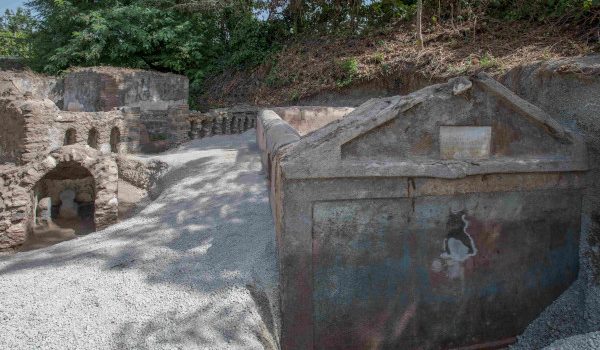The tomb of Marcus Venerius Secundio discovered at Porta Sarno with mummified human remains
Mummified remains, along with the hair and bones of an individual buried in an ancient tomb have been found at the necropolis of Porta Sarno, to the east of the ancient urban centre of Pompeii. On a marble slab located on the pediment of the tomb, a commemorative inscription to the owner Marcus Venerius Secundio makes reference, extraordinarily, to performances at Pompeii that were conducted in Greek, direct evidence of which has never before been found.
This is the latest discovery at Pompeii, which took place during an excavation campaign carried out in the Porta Sarno Necropolis area, on the initiative of the Archaeological Park of Pompeii and the European University of Valencia.
“Pompeii never ceases to amaze, and has confirmed her place in a story of redemption, as an international role model, and a place where research and new archaeological excavations are taking place once more, thanks to the many professionals in the field of cultural heritage, who with their work never cease to produce extraordinary results for the world which are a source of pride for Italy.”- Declares the Minister of Culture, Dario Franceschini.
The tomb structure, which dates to the final decades in the life of the city, consists of a masonry enclosure, with traces of paint preserved on the façade: it is possible to distinguish green plants on a blue background.
The figure of Marcus Venerius Secundio - who also appears in the wax tablet archive of the Pompeian banker Cecilius Giocondus, owner of the domus of the same name on Via Vesuvio - was a public slave and custodian of the Temple of Venus. Upon being freed, he reached a certain social and economic status, as can be understood from the rather monumental tomb, and the inscription: in addition to joining the ranks of the Augustales, or the college of priests dedicated to the Imperial Cult, as the epigraph recalls he “gave Greek and Latin ludi for the duration of four days”.
“Ludi graeci are to be understood as performances in the Greek language”, – observes the Director of the Archaeological Park of Pompeii, Gabriel Zuchtriegel – “It is the first clear evidence of performances at Pompeii in the Greek language, which had previously been hypothesised on the basis of indirect indicators. Here we have another tessera of a large mosaic, namely the multi-ethnic Pompeii of the early Imperial Age, where Greek, the then lingua franca of the eastern Mediterranean, is indicated alongside Latin. That performances in Greek were organised is evidence of the lively and open cultural climate which characterised ancient Pompeii, similar to how the special exhibition of Isabelle Huppert, held in French at the Large Theatre a few weeks ago, showed that culture has no borders.”
No less exceptional than the inscription is the burial of Marcus Venerius Secundio, with one of the best preserved skeletons ever found in the ancient city. The deceased was buried in a small cell of 1.6 x 2.4 metres, located behind the main façade, while in the remaining part of the enclosure evidence of cremation has been found, in the form of two cinerary urns, one of which is a beautiful glass container belonging to a woman by the name of Novia Amabilis. During the Roman period at Pompeii, funeral rites usually involved cremation, while only small children were buried.
The burial of Marcus Venerius is thus highly unusual also for the funeral rite that was adopted, considering that he was an adult man over 60 years of age, as evidence emerging from the initial analysis of bones found in the burial chamber indicates. The characteristics of the funerary chamber, which consisted of a hermetically sealed room, created conditions that allowed for the exceptional state of preservation in which the skeleton was found, with hair and an ear still visible. Furthermore, grave goods have been recovered, including two glass unguentaria and numerous fragments of what appears to be fabric.
“We still need to understand whether the partial mummification of the deceased is due to intentional treatment or not” - explains Professor Llorenç Alapont of the University of Valencia - “analysis of the fabric could provide further information on this. From the sources we know that certain textiles such as asbestos were used in embalming. Even for those like me, who have been specialised in funerary archaeology for some time, the extraordinary wealth of information offered by this tomb, from the inscription to the burials, the osteological finds and the painted façade, is exceptional, which confirms the importance of adopting an interdisciplinary approach, such as that conducted by the University of Valencia and the Archaeological Park during this project”.
The human and organic remains found in the funerary complex of Porta Sarno were transported to the Laboratory of Applied Research at the site of Pompeii, where they have undergone analysis and conservation interventions. At the same time, the Archaeological Park has begun a series of stabilisation interventions, aimed at ensuring the maintenance of the Porta Sarno Necropolis, pending the definition of a broader project aimed at restoration and eventual visitor access to the area. The necropolis is currently not accessible to visitors since it is located beyond the Circumvesuviana railway line, but the Park has launched a feasibility study with a view to including it in the area which is open to the public.
The excavation and recovery operations by the University of Valencia were coordinated by Prof. Llorenç Alapont of the Department of Prehistory and Archaeology, alongside archaeologist Luana Toniolo, restorer Teresa Argento and anthropologist Valeria Amoretti of the Archaeological Park.
Link Foto
https://we.tl/t-ZtjQaHc3dj
Link Video
https://we.tl/t-jkBjH57JtY (interview in italian with director general Gabriel Zuchtriegel)
https://we.tl/t-Q9ziP6tBtl (laser scan skeleton images)
https://we.tl/t-U4wVUPbPpR (other video images)


